Birdwatching can propel tourism growth in Caspian Sea island

TEHRAN – Ashuradeh, Iran’s sole island in the Caspian Sea, and its surrounding wetlands constitute a rich ecological haven for many migratory birds. However, birdwatching has remained somehow an untapped potential for tourism growth in the coastal region.
Some experts believe the presence of migratory birds along with rare bird species that are wintering in and around the island including the Gorgan Bay has provided an excellent opportunity for birdwatching tours.
Birdwatching can be the key driver for development of tourism in the region if it becomes a major destination for birdwatchers and bird buffs, IRNA quoted an environmental wildlife expert as saying on Monday.
“Infrastructure development measures such as constructing more ranger stations, local and rural eco-lodges are essential for making a boom in nature tourism and birdwatching in Golestan [province],” Mehdi Rajabi added.
“Construction of hiking trails and training local guides are also among necessities for promoting tourism in the region,” he noted.
Birdwatching, the observation of live birds in their natural habitat, is a popular pastime and scientific sport that developed almost entirely in the 20th century.
The report however added that birdwatcher tourists do not care about tourism infrastructure as much as other holidaymakers do and they [usually prefer to] spend most of their time in the wild, so hotels, transport and restaurants do not play a very leading in such a tourism industry.
The south Caspian Sea retreat will remain dominated by its northerly guests until about mid-May when the migration season comes to an end. In a wider scene, the mid-winter population of the migratory birds is estimated to exceed over a million in the whole southern sandy shorelines of the Caspian Sea that spans some 700km.
The northern provinces of Gilan, Golestan, and Mazandaran embrace a variety of freshwater lakes, wetlands, and lagoons, which are the main destinations for traveling pelicans, flamingos, ducks, swans, coots and some other species.
AFM/MG
